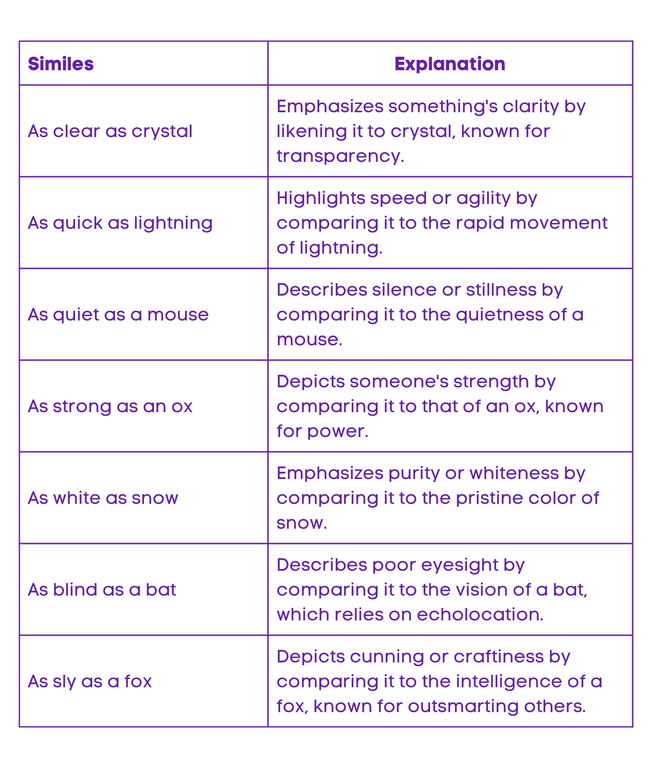Understanding Simile: Exploring the Power of Figurative Language
Table of Contents
Introduction
Simile
Simile is a figure of speech that involves comparing one thing with another thing of a different kind, using the words “like” or “as” to make the comparison. It is a powerful tool in literature and language that adds depth and vividness to descriptions and narratives. Let’s delve into the world of simile and understand its significance in communication and creative expression.
Analogy of Definition
What is Simile?
A simile is a literary device that draws a comparison between two different things, highlighting their similarities. It often uses the words “like” or “as” to establish the connection between the two elements being compared. By using similes, writers and speakers can create imagery, evoke emotions, and convey complex ideas in a more relatable and engaging manner.
Method
Using Simile
Similes can be used in various ways to enhance the impact of written and spoken communication. They can be employed to create vivid descriptions, convey emotions, and emphasize the characteristics of a person, object, or situation. Similes are effective in engaging the audience and making the content more memorable and impactful.
Simile and Metaphors
While similes employ “like” or “as” to draw comparisons, metaphors directly assert that one thing is another. Distinguishing between these two forms of comparison is crucial.
Consider these examples:
“Her smile was like sunshine on a rainy day.” (Simile)
“Her smile was a ray of sunshine in my cloudy day.” (Metaphor)
“The city streets were as busy as a beehive.” (Simile)
“The city streets were a buzzing beehive of activity.” (Metaphor)
It’s interesting to note: since both similes and metaphors create figurative comparisons, all similes can be considered metaphors, but not all metaphors involve “like” or “as” comparisons. When seeking similes, keep “like” and “as” in mind, and you’ll easily spot them in literary works and conversations.
Simile and Exaggeration
Similes are often used in conjunction with exaggeration to create vivid and impactful descriptions. By comparing something to an exaggerated or extreme example, similes can intensify the imagery and emotions conveyed in a literary work or a spoken narrative. This combination of simile and exaggeration adds depth and emphasis to the intended message, leaving a lasting impression on the audience.
Here’s an example:
“Her laughter was like a thunderstorm, booming and echoing through the room, shaking the very foundation of our spirits.”
In this simile, the laughter is compared to a thunderstorm, which is an exaggerated and extreme example. The comparison emphasizes the intensity and power of the laughter. Like a thunderstorm, her laughter is described as booming, echoing, and capable of shaking spirits, implying that it’s loud, infectious, and deeply impactful. This vivid imagery helps the audience to visualize and feel the strength of her laughter, leaving a lasting impression of its magnitude.
Simile and Hyperbole
Hyperbole is a figure of speech that involves extreme exaggeration to make a point or create a strong impression. When combined with simile, hyperbole can amplify the impact of the comparison, intensifying the imagery and emotions evoked by the simile. This fusion of simile and hyperbole results in powerful and memorable expressions that resonate with the audience.
For instance:
“The suitcase weighed a ton, making it feel like I was lugging around a small elephant.”
In this example, the hyperbole exaggerates the weight of the suitcase, emphasizing its heaviness. By comparing it to “a ton” and “a small elephant,” the speaker vividly communicates the immense burden of carrying the suitcase. While the actual weight may not be a literal ton, the hyperbolic exaggeration amplifies the impression of its weightiness. The simile further enhances this effect by providing a visual image of the situation, allowing the audience to imagine the physical struggle of carrying something as heavy as a small elephant. Together, the fusion of simile and hyperbole creates a powerful and memorable expression that effectively conveys the overwhelming weight of the suitcase.
Similes often incorporate hyperbole, which involves exaggeration:
He dashes as swiftly as a shooting star.
This simile compares the speed of “he” to that of a shooting star, which is known for its incredible velocity as it streaks across the sky. By likening his dashing to the speed of a shooting star, the speaker exaggerates his swiftness, emphasizing just how fast he moves. This hyperbolic comparison intensifies the imagery and emphasizes the rapidity of his movement.
Their kindness is as sweet as a fresh morning breeze.
Here, the simile compares the sweetness of “their kindness” to the refreshing quality of a fresh morning breeze. Morning breezes are often associated with a pleasant, gentle sweetness as they sweep through the air. By likening their kindness to this, the speaker exaggerates its sweetness, highlighting the warm and comforting nature of their actions. This hyperbolic comparison amplifies the emotional impact of their kindness.
Your voice resonates like a chorus of angels.
In this simile, the speaker compares the resonance of “your voice” to that of a chorus of angels. Angelic voices are often depicted as heavenly and ethereal, resonating with a pure and melodious quality. By likening the resonance of the voice to a chorus of angels, the speaker exaggerates its beauty and clarity, emphasizing its captivating and uplifting effect. This hyperbolic comparison intensifies the imagery and evokes a sense of awe and admiration for the voice.
Similes provide a focused comparison, preventing hyperbolic statements from appearing excessive. Consider these sentences:
- Elliot is a stubborn mule.
- Elliot is as stubborn as a mule.
The first statement is a metaphor, but its directness might come across as rudimentary or unsubtle. In contrast, the second version, a simile, highlights the specific trait Elliot shares with mules: stubbornness.
Examples
1. “As brave as a lion”
Explanation: This simile compares someone’s bravery to the fearless nature of a lion, emphasizing their courage and strength.
2. “As light as a feather”
Explanation: This simile conveys the lightness of an object or a feeling by comparing it to the weightlessness of a feather, creating a sense of delicacy and ease.
3. “As busy as a bee”
Explanation: This simile illustrates someone’s level of activity and industriousness by likening it to the constant buzzing and movement of a bee, highlighting their energy and diligence.

Quiz
Tips and Tricks
1. Creating Vivid Imagery
Tip: Use similes to paint vivid pictures in the minds of your audience, comparing elements to relatable or striking examples to enhance the descriptive quality of your writing or speech.
2. Evoking Emotions
Tip: Employ similes to evoke specific emotions in your audience, drawing comparisons that resonate with their feelings and experiences to create a deeper connection.
3. Adding Depth to Descriptions
Tip: Enhance the depth of your descriptions by using similes to emphasize the unique qualities and characteristics of the subjects you are portraying, making them more memorable and impactful.
4. Engaging the Audience
Tip: Engage your audience by incorporating similes into your content, capturing their attention and stimulating their imagination with vivid and relatable comparisons.
5. Making Content Memorable
Tip: Make your content more memorable by using similes to create lasting impressions, leaving a strong and lasting impact on your audience through powerful and evocative comparisons.
Real life application
Story: “The Simile Adventures of Sarah and James”
Sarah and James were two imaginative friends who loved exploring the world of similes and discovering their real-life applications. As they embarked on various adventures, they encountered situations where similes played a significant role in communication and creative expression.
Adventure 1: The Art of Storytelling
Sarah and James participated in a storytelling competition, where they used similes to bring their narratives to life. By comparing characters and events to relatable or striking examples, they captivated the audience and won the competition with their vivid and engaging stories.
Adventure 2: The Power of Persuasion
In a debate competition, Sarah and James utilized similes to persuade the audience and convey their arguments effectively. By drawing comparisons that resonated with the listeners, they made their points more compelling and convincing, ultimately winning the debate with their impactful use of similes.
Adventure 3: The World of Advertising
As they explored the world of marketing and advertising, Sarah and James discovered how similes were used to create memorable slogans and catchphrases. By comparing products and brands to relatable or aspirational examples, advertisers effectively captured the attention and interest of their target audience, leaving a lasting impression.
FAQ's
Like? Share it with your friends






